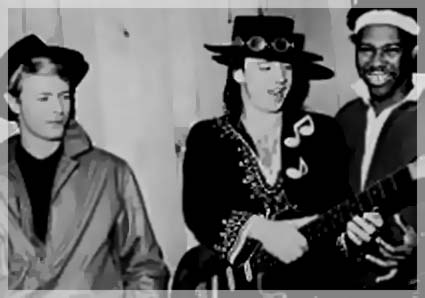Article in Musician magazine by Nelson George - May 1983 Pictures and text transcribed by Ben
 |
Dancing With Nile Rodgers
"Because of the nature of the business, people are not that keen on intermingling between blacks and whites. They don't expect that a black producer can go in and do an artist of the caliber of David Bowie."
Nile Rodgers, exceptional guitarist, co-producer of the influential funk-disco minimalist band Chic, brand new solo artist with Adventures In The Land Of The Good Groove album just released and aficionado of Thai cuisine, is talking with considerable enthusiasm about producing (of all people) David Bowie. "David could have had any producer-white or black-he wanted. He could have gone with Quincy Jones and a more sure-fire chance at a hit. But he called me up, and for that I feel honored".
The musical marriage of the chameleonlike Bowie and fun-master Rodgers on Let's Dance is one of the more unexpected collaborations of recent years and also one of the fastest. From the late December night that Bowie telephoned Rodgers and later met in Rodgers Manhattan apartment, to the album's final mix, the entire project took all of five weeks, only three of which were spent actually cutting and mixing the record at New York's Power Station.
This is the fastest I've ever worked in my life," says Rodgers in an amazed tone. "We went in from about ten a.m. to the early evening for six days a week and worked. Before recording here we spent three days cutting demos of his songs, son when we actually got into the studio, we knew exactly what we wanted.
"Bowie said he likes to work this way and I plan to do the same for the rest of my career,: enthuses Nile. "It's just the most energetic way to make records. The musicians were really pumped up because of the fast pace, and, as a result we got some great performances."
Rodgers was well equipped to arrange Let's Dance's 50s R&B bounce, flush with big, brassy horns: "It was as through jazz and arranging that I originally got into music. I studied orchestration books, big bands, harmony...I mean, I've got a library on orchestration at home that's up to the ceiling. That's what I really love. I wrote the arrangements based on the demos. When they were played against the tracks, David and I would make some alterations, but nothing very radical. We heard the music the same way and didn't have a major disagreement over any musical point, as happened when we produced Diana Ross."
Austin -based white bluesman Stevie Ray Vaughn (He's got that bluesy Buddy Guy guitar thing down cold) was signed by Bowie even before Rodgers was contacted. Rodgers selected the rest of the musicians, trying for a mix of young blood and New York studio veterans. Weather Report drummer Omar Hakim plays on the bulk of the album with Chic's Tony Thompson appearing on three songs. Carmine Rojas, bassist for Nona Hendryx's Propaganda, handles all the bottom-end chores except one cut where Chic's Bernard Edwards sits in. Percussionist Sammy Figueroa and keyboardist Rob Sabino both Chic regulars, round out the rhythm section. Rodgers' horn charts were performed by members of the Asbury Jukes.
Rodgers was quite impressed with Bowie's musical knowledge. "Unlike some of the groups I've worked with in the past, where Bernard and I had to take charge in the studio, David has a deep understanding of music. He knows a lot more then he gets credit for. We spent time discussing chords , notes and different approaches to music. At one point David was so enthusiastic about capturing that rock 'n' roll flavor that he wanted to cut everything live-rhythm, horns and vocals. That's how open he was to doing the unusual."
Nile has two personal favorites, "Modern Love" and the title cut. "'Modern Love' is an old barrelhouse rocker with a real pounding Little Richard-type piano, while on top it has a very sophisticated jazz horn sound." He feels "everybody is gonna think I wrote 'Let's Dance' because it has that Chic feel with Bernard playing a real walking bass' the bass line is in fact, very much like the one in 'Good Times'.
But what is unique about the song, and about David's music in general, is that he doesn't feel he has to be harnessed by any boundaries, so the horns are soloing all over the place and doing John Coltrane-type runs.
"I remember David and I had a talk about our philosophies of making music and he said he was never afraid to change, because he never liked to limit himself to appealing to a certain class or audience. David says he has always felt the freedom to be flexible and to do as he wished, even if it didn't sell. I think this album reflects that freedom."
  |